An Examination of Social, Phonetic, and Lexical Variables on the Lenition of Intervocalic Voiced Stops by Spanish Heritage Speakers
Abstract
1. Introduction
2. Literature Review
2.1. Intervocalic Voiced Stops in Spanish and English
| 1a. Word medial: él bebe [el-ˈbe-βe] ‘he drinks’ | 1b. Word initial: yo bailo [ʝo-ˈβaj-lo] ‘I dance’ | |
| 2a. Word medial: el dedo [el-ˈde-ðo] ‘the finger’ | 2b. Word initial: la dama [la-ˈða-ma] ‘the lady’ | |
| 3a. Word medial: él llega [el-ˈʝe-ɣa] ‘he arrives’ | 3b. Word initial: ella gana [ˈe-ʝa-ˈɣa-na] ‘she wins’ |
| 4a. Word medial: a baby [ə-ˈbeɪ-bi] | 4b. Word initial: a baby [ə-ˈbeɪ-bi] | |
| 5a. Word medial: today [tə-ˈdeɪ] | 5b. Word initial: a dance [ə-dæns] | |
| 6a. Word medial: wagon [ˈwæ-gɪn] | 6b. Word initial: a ghost [ə-goʊst] |
2.2. Linguistic Factors Affecting /bdg/ Lenition
2.3. Social Factors Affecting /bdg/ Lenition
2.4. Cognate Status Effects in Spanish-English Speakers
- Which social factors (age of acquisition of Spanish, number of family generations in the US, and weekly contact hours with Spanish) have an impact on heritage speakers’ lenition of /bdg/?
- Does vowel height affect the lenition of /bdg/ among heritage speakers?
- Does the cognate status of the lexical item have an impact on heritage speakers’ lenition of /bdg/?
3. Materials and Methods
3.1. Participants
3.2. Instruments
3.3. Analysis
4. Results
4.1. Overall Lenition Rates
4.2. Research Question 1: Effects of Generation, Contact Hours, and Age of Acquisition of Spanish
4.3. Research Question 2: Phonetic Context
4.4. Research Question 3: Cognate Effects
5. Discussion
5.1. Research Question 1: Effects of Generation, Contact Hours, and Age of Acquisition of Spanish
5.2. Research Question 2: Phonetic Context
5.3. Research Question 3: Cognate Effects
5.4. Limitations
6. Conclusions
Author Contributions
Funding
Institutional Review Board Statement
Informed Consent Statement
Data Availability Statement
Acknowledgments
Conflicts of Interest
Appendix A
- What is your name?
- How old are you?
- Are you a current university student?
- What language did you learn from birth?
- What language or languages have you learned since then?
- At what age did you start learning/speaking/hearing them?
- Where did your family immigrate from?
- Has your use of Spanish decreased as you got older or has it remained the same?
- How many generations of your family have lived in the United States?
- Does it feel like you can listen and understand but cannot speak Spanish?
- 11.
- Do you SPEAK in Spanish in any of the following contexts? If yes, indicate the frequency by checking the appropriate box.
Always Often Sometimes Seldom Never N/A With your mother, father, or both With your grandparents With your siblings With at least one of your relatives With at least one of your friends At work At school At social events Others: Please specify - 12.
- Do the following people ADDRESS you in Spanish in any of the following contexts? If yes, indicate the frequency by checking the appropriate box.
Always Often Sometimes Seldom Never N/A With your mother, father, or both With your grandparents With your siblings With at least one of your relatives With at least one of your friends At work At school At social events Others: Please specify - 13.
- Do you listen to conversations in Spanish between the following people? If yes, indicate the frequency by checking the appropriate box.
Always Often Sometimes Seldom Never N/A With your mother, father, or both With your grandparents With your siblings With at least one of your relatives With at least one of your friends At work At school At social events Others: Please specify
- 14.
- How many hours per week do you SPEAK or LISTEN TO Spanish?
N/A Never 1–2 h a week 3–4 h a week 5–6 h a week More - 15.
- How many hours per week do you SPEAK or LISTEN TO Spanish with your grandparents?
N/A Never 1–2 h a week 3–4 h a week 5–6 h a week More - 16.
- How many hours per week do you SPEAK or LISTEN TO Spanish with your parents?
N/A Never 1–2 h a week 3–4 h a week 5–6 h a week More - 17.
- How many hours per week do you SPEAK or LISTEN TO Spanish with your siblings?
N/A Never 1–2 h a week 3–4 h a week 5–6 h a week More - 18.
- How many hours per week do you SPEAK or LISTEN TO Spanish with your friends?
N/A Never 1–2 h a week 3–4 h a week 5–6 h a week More - 19.
- Do you watch any TV or movies in Spanish?
N/A Never 1–2 h a week 3–4 h a week 5–6 h a week More - 20.
- Do you listen to any Spanish music?
N/A Never 1–2 h a week 3–4 h a week 5–6 h a week More
- 21.
- Do you attend functions or events in which the dominant language is Spanish?
- 22.
- If so, what are the events?
- 23.
- Have you ever studied in or visited Spanish speaking countries or communities such as the US /Mexico border where you were immersed in Spanish most of or all of the time?
- 24.
- If so, where did you go and how long were you there for?
- 25.
- Have you used Spanish in any other situations? (i.e., job, volunteer work, etc.)
- 26.
- Have you ever taken a Spanish class?
- 27.
- If so, when was the last time you took a Spanish class?
- 28.
- How many hours per week do/did you spend in a formal Spanish class?
- 29.
- How many quarters, semesters, or years of Spanish classes did you take?
- 30.
- What was your motivation for taking the class?
Appendix B
| Abogado | Lawyer |
| Aburrido | Boring |
| Beber | To drink |
| Bodega | Store |
| Colorado* | Colorado |
| Cuba* | Country |
| Debate* | Debate |
| Dedo | Finger |
| Dibujar | To Draw |
| Empanada* | Empanada (food) |
| Galápago * | Ecuador Islands |
| Graduación* | Graduation |
| Grabar | To Record |
| Hago | I do |
| Hormigas | Ants |
| Idea* | Idea |
| Inseguro | Unsure/Unsafe |
| Legal* | Legal |
| Liga * | League |
| Madrugada | Early Morning |
| Murciélago | Bat (animal) |
| Negociar* | To Negotiate |
| Obediente* | Obedient |
| Prohibir* | To Prohibit |
| Quedaba | Stayed |
| Radio* | Radio |
| Regatear | To Bargain |
| Segundo | Second |
| Sílaba* | Syllable |
| Tímido* | Timid |
| Trabajaba | Worked |
| Universidad* | University |
| Vídeo* | Video |
Appendix C
| Segment | N | Fixed Effects | ß | SE | t | p | Random Effects | Variance | SD |
|---|---|---|---|---|---|---|---|---|---|
| /b/ | 252 | Intercept | 3.03 | 0.32 | 9.33 | <0.001 | Speaker | 0.56 | 0.37 |
| AoAS | ns | ||||||||
| Generation | −0.41 | 0.13 | −3.23 | 0.001 | |||||
| Age | ns | ||||||||
| Contact Hours | ns | ||||||||
| Preceding low | ns | ||||||||
| Preceding mid | −0.29 | 0.14 | −2.15 | 0.03 | |||||
| Following low | ns | ||||||||
| Following mid | 0.34 | 0.14 | 2.41 | 0.02 | |||||
| /d/ | 292 | Intercept | 2.81 | 0.34 | 8.29 | <0.001 | Speaker | 0.66 | 0.38 |
| AoAS | ns | ||||||||
| Generation | −0.4 | 0.13 | −2.95 | 0.003 | |||||
| Age | ns | ||||||||
| Contact Hours | ns | ||||||||
| Preceding low | 0.34 | 0.09 | 3.69 | <0.001 | |||||
| Preceding mid | ns | ||||||||
| Following low | ns | ||||||||
| Following mid | ns | ||||||||
| /g/ | 276 | Intercept | 2.43 | 0.25 | 9.67 | <0.001 | Speaker | 0.66 | 0.23 |
| AoAS | ns | ||||||||
| Generation | −0.34 | 0.09 | −3.55 | 0.002 | |||||
| Age | ns | ||||||||
| Contact Hours | ns | ||||||||
| Preceding low | ns | ||||||||
| Preceding mid | 0.46 | 0.1 | 4.56 | <0.001 | |||||
| Following low | ns | ||||||||
| Following mid | ns |
References
- Acevedo, Mary Ann. 1993. Development of Spanish Consonants in Preschool Children. Journal of Childhood Communication Disorders 15: 9–15. [Google Scholar] [CrossRef]
- Amengual, Mark. 2012. Interlingual influence in bilingual speech: Cognate Status Effect in a Continuum of Bilingualism. Bilingualism 15: 517–30. [Google Scholar] [CrossRef]
- Anthony, Jonathan Jd Robinson, and Henrike K. Blumenfeld. 2019. Language dominance predicts cognate effects and inhibitory control in young adult bilinguals. Bilingualism 22: 1068–84. [Google Scholar] [CrossRef]
- Balukas, Colleen, and Christian Koops. 2014. Spanish-English Bilingual Voice Onset Time in Spontaneous Code-switching. International Journal of Bilingualism 20: 1–21. [Google Scholar] [CrossRef]
- Bates, Douglas, Martin Maechler, Ben Bolker, and Steve Walker. 2015. Fitting linear mixed-effects models using lme4. Journal of Statistical Software 67: 1–48. [Google Scholar] [CrossRef]
- Beaudrie, Sara, Cynthia Ducar, and Kim Potowski. 2015. Goals and Principles in Heritage Language Instruction. In Heritage Language Teaching: Research and Practice. New York: McGraw Hill, vol. 4, pp. 57–60. [Google Scholar]
- Boada, Roger, Rosa Sãnchez-Casas, José M. Gavilãn, José E. Garcãa-Albea, and Natasha Tokowicz. 2013. Effect of multiple translations and cognate status on translation recognition performance of balanced bilinguals. Bilingualism 16: 183–97. [Google Scholar] [CrossRef]
- Boersma, Paul, and David Weenink. 2018. Praat: Doing Phonetics by Computer [Computer Program]. Version 6.0.37. Available online: http://www.praat.org/ (accessed on 1 November 2019).
- Díaz-Campos, Manuel. 2005. The Emergence of Adult-like Command of Sociolinguistic Variables: A Study of Consonant Weakening in Spanish-speaking Children. In Selected Proceedings of the 6th Conference on the Acquisition of Spanish and Portuguese as First and Second Languages. Edited by David Eddington. Somerville: Cascadilla Proceedings Project, pp. 56–65. [Google Scholar]
- Carroll, E. Susanne. 1992. On cognates. Interlanguage Studies Bulletin (Utrecht) 8: 93–119. [Google Scholar] [CrossRef]
- Escobar, Anna María, and Kim Potowski. 2015. La adquisición del español como lengua minoritaria. In El Espanol de los Estados Unidos. Cambridge: Cambridge University Press, pp. 81–111. [Google Scholar]
- Fabiano-Smith, Leah, and Brian A. Goldstein. 2010. Phonological acquisition in bilingual Spanish–English speaking children. Journal of Speech, Language, and Hearing Research. [Google Scholar] [CrossRef]
- Fishman, A. Joshua. 2001. 300-Plus Years of Heritage Language Education in the United States. In Heritage Langauge in America: Preserving a National Resource. Edited by Joy Kreeft Peyton, Donald A. Ranard and Scott McGinnis. Washington and McHenry: Center for Applied Linguistics and Delta Systems, pp. 81–89. [Google Scholar]
- Flege, James, and Murray Munro. 1994. The word unit in L2 speech production and perception. Studies in Second Language Acquisition 16: 381–411. [Google Scholar] [CrossRef]
- Flege, James, Elaina Frieda, Amanda Walley, and Lauren Randazza. 1998. Lexical Factors and Segmental Accuracy in Second Language Speech Production. Studies in Second Language Acquisition 20: 155–87. [Google Scholar] [CrossRef]
- Henriksen, C. Nicholas. 2015. Acoustic analysis of the rhotic contrast in Chicagoland Spanish: An Intergenerational Study. Linguistic Approaches to Bilingualism 5: 285–321. [Google Scholar] [CrossRef]
- Hualde, I. José. 2014. Los Sonidos Del Español. Cambridge: Cambridge University Press. [Google Scholar]
- Kim, Ji Young, and Gemma Repiso-Puigdelliura. 2020. Deconstructing Heritage Language Dominance: Effects of Proficiency, Use, and Input on Heritage Speakers’ Production of the Spanish Alveolar Tap. Phonetica 77: 55–80. [Google Scholar] [CrossRef]
- Kissling, M. Elizabeth. 2013. Teaching pronunciation: Is explicit phonetics instruction beneficial for FL learners? The Modern Language Journal 97: 720–44. [Google Scholar] [CrossRef]
- Kissling, M. Elizabeth. 2015. Phonetics instruction improves learners’ perception of L2 sounds. Language Teaching Research 19: 254–275. [Google Scholar] [CrossRef]
- Leeman, Jennifer. 2005. Engaging critical pedagogy: Spanish for native speakers. Foreign Language Annals 38: 35–45. [Google Scholar] [CrossRef]
- Limanni, Anna. 2009. Men, Women and Lenition: Gender Differences in the Production of Intervocalic Voiced Stops in Mexican Spanish. Canadian Acoustics 37: 194–95. [Google Scholar]
- MacGregor-Mendoza, Patricia. 2000. Aquí No Se Habla Español: Stories of Linguistic Repression in Southwest Schools. Bilingual Research Journal 24: 355–67. [Google Scholar] [CrossRef]
- Otheguy, Ricardo, and Ana C. Zentella. 2011. Spanish in New York: Language Contact, Dialectal Leveling, and Structural Continuity. Oxford: OUP USA. [Google Scholar]
- Port, Robert F. 2010. Rich Memory and Distributed Phonology. Language Sciences 32: 43–55. [Google Scholar] [CrossRef]
- Potowski, Kim. 2013. Heritage Learners of Spanish. In The Handbook of Spanish Second Language Acquisition. Edited by Kimberly L. Geeslin. Hoboken: John Wiley & Sons, pp. 404–22. [Google Scholar]
- Preacher, Kristopher J. 2001. Calculation for the Chi-Square Test: An Interactive Calculation Tool for Chi Square Tests of Goodness of Fit and Independence. [Computer Software]. Available online: www.quantpsy.org/chisq/chisq.htm (accessed on 14 June 2021).
- Rao, Rajiv. 2014. On the status of the phoneme /b/ in heritage speakers of Spanish. Sintagma 26: 37–54. [Google Scholar]
- Rao, Rajiv. 2015. Manifestations of /bdg/ in Heritage Speakers of Spanish. Heritage Language Journal (1550–7076) 12: 48. [Google Scholar] [CrossRef]
- Ronquest, Rebecca, and Rajiv Rao. 2018. Heritage Spanish Phonetics and Phonology. In The Routledge Handbook of Spanish as a Heritage Language. Edited by Kim Potowski. London: Routledge, pp. 164–77. [Google Scholar]
- Ronquest, Rebecca, Jim Michnowicz, Eric Wilbanks, and Claudia Cortes. 2020. Examining the (mini-) Variable Swarm in the Spanish of the Southeast. Philadelphia: John Benjamins Publishing Company. [Google Scholar] [CrossRef]
- RStudio Team. 2020. RStudio: Integrated Development for R. RStudio, PBC, Boston, MA. Available online: http://www.rstudio.com/ (accessed on 14 June 2021).
- Silva-Corvalán, Carmen. 2014. Bilingual Language Acquisition: Spanish and English in the First Six Years. Cambridge: Cambridge University Press. [Google Scholar]
- Simonet, Miquel, José I. Hualde, and Marianna Nadeu. 2012. Lenition of/d/in spontaneous Spanish and Catalan. In Thirteenth Annual Conference of the International Speech Communication Association. Portland: Interspeech. [Google Scholar]
- Thomas, Erik. 2011. Sociophonetics: An Introduction. New York: Macmillan International Higher Education. [Google Scholar]
- Valdés, Guadalupe. 2001. Heritage language students: Profiles and possibilities. In Heritage Languages in America: Preserving a National Resource. Edited by Joy Kreeft Peyton, Donald A. Ranard and Scott McGinnis. Washington: CAL, ERIC, McHenry: DeltaSystems, pp. 37–80. [Google Scholar]
- Waltermire, Mark. 2017. At the Dialectal Crosswords: The Spanish of Albuquerque, New Mexico. Dialectología 19: 177–97. [Google Scholar]
- Zampini, Mary. 1998. L2 Spanish spirantization: A prosodic analysis and pedagogical implications. Hispanic Linguistics 10: 154–88. [Google Scholar]
| 1 | In Spanish, the voiceless stops have a short period between the release of the consonant and the onset of vowel voicing. In English, word position and cluster position affect VOT (voice onset time), but in general, English voiceless stops have longer VOTs than the same segments in Spanish (Hualde 2014; Thomas 2011). |
| 2 | Some speakers of varieties of Colorado and New Mexican Spanish have retained the labiodental realization of [v] that corresponds to the grapheme “v” in a word like universidad (Waltermire 2017). This feature has been passed down throughout younger generations although the younger generations use them less “since many of them do not speak Spanish and largely possess receptive skills in this language” (2017, p.180). While a reviewer pointed out that this feature may apply more directly to third generation speakers and beyond, it is also possible that younger speakers have adopted the feature if it is frequent enough in their speech community. It is also possible that the influence of these bilinguals’ other language, English, maintains the phonological contrast. Regardless of the justification of labiodental maintenance, its phonetic characteristics fall outside of the spectrum of lenition we are investigating. |
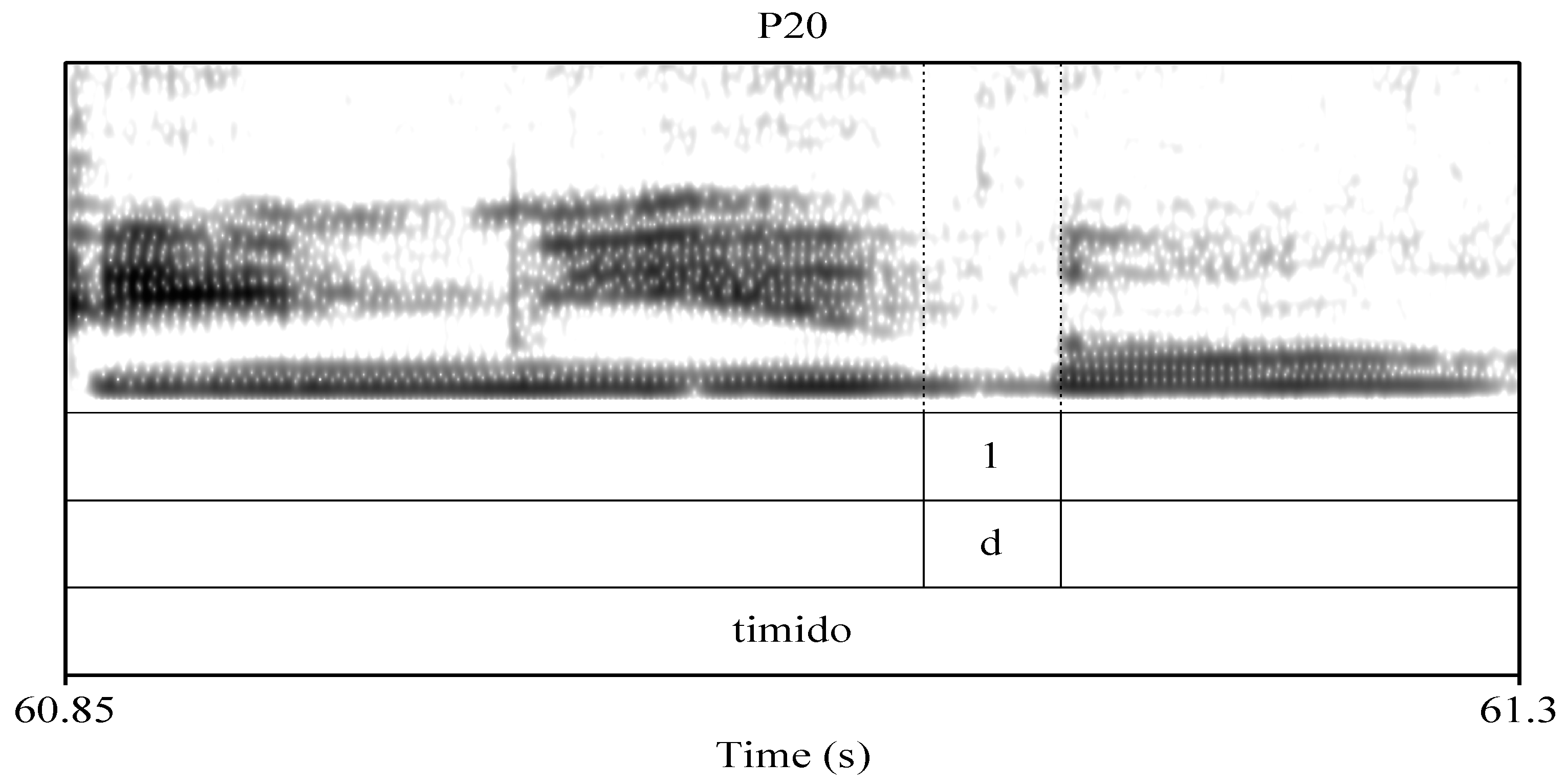
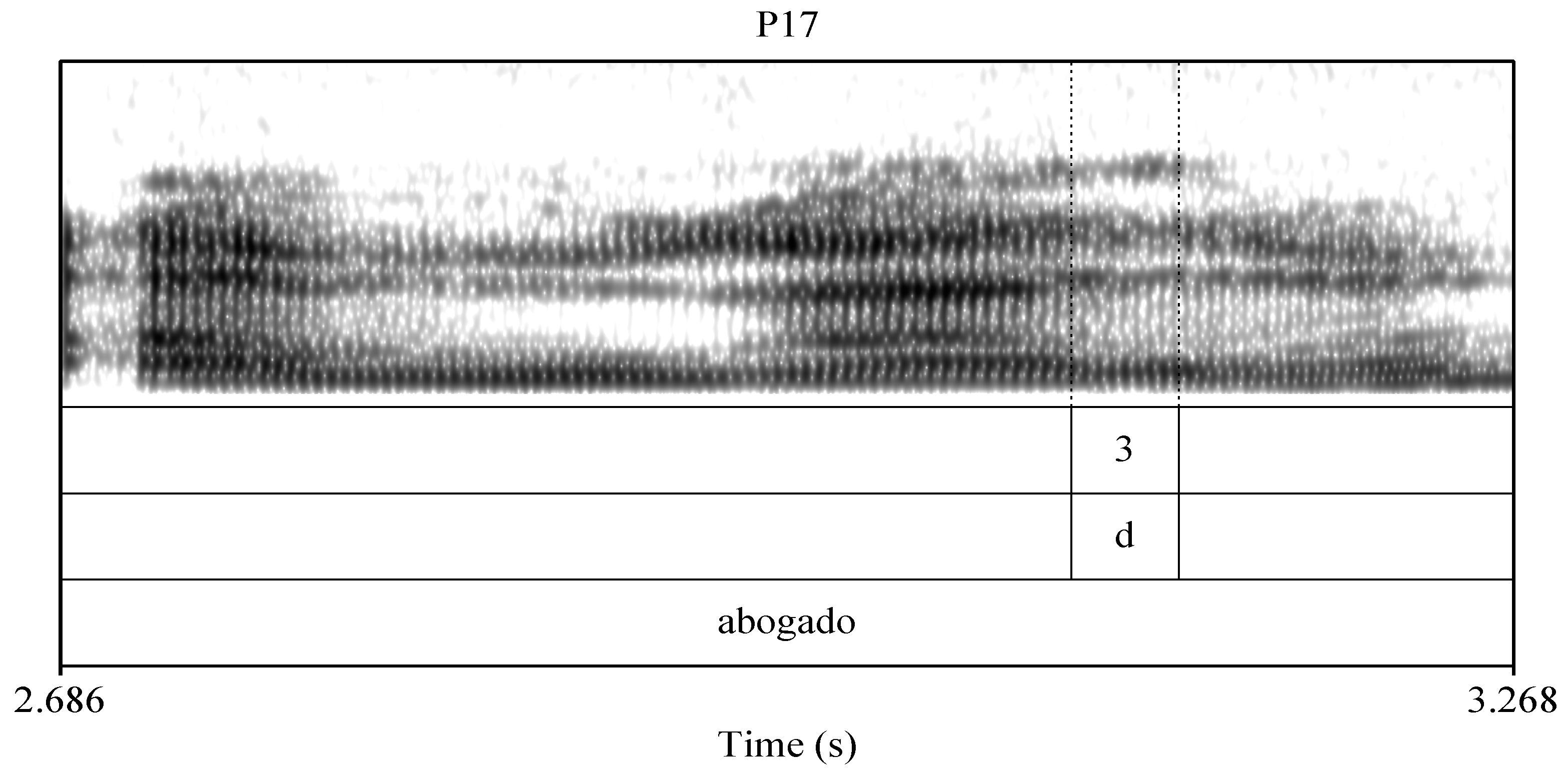
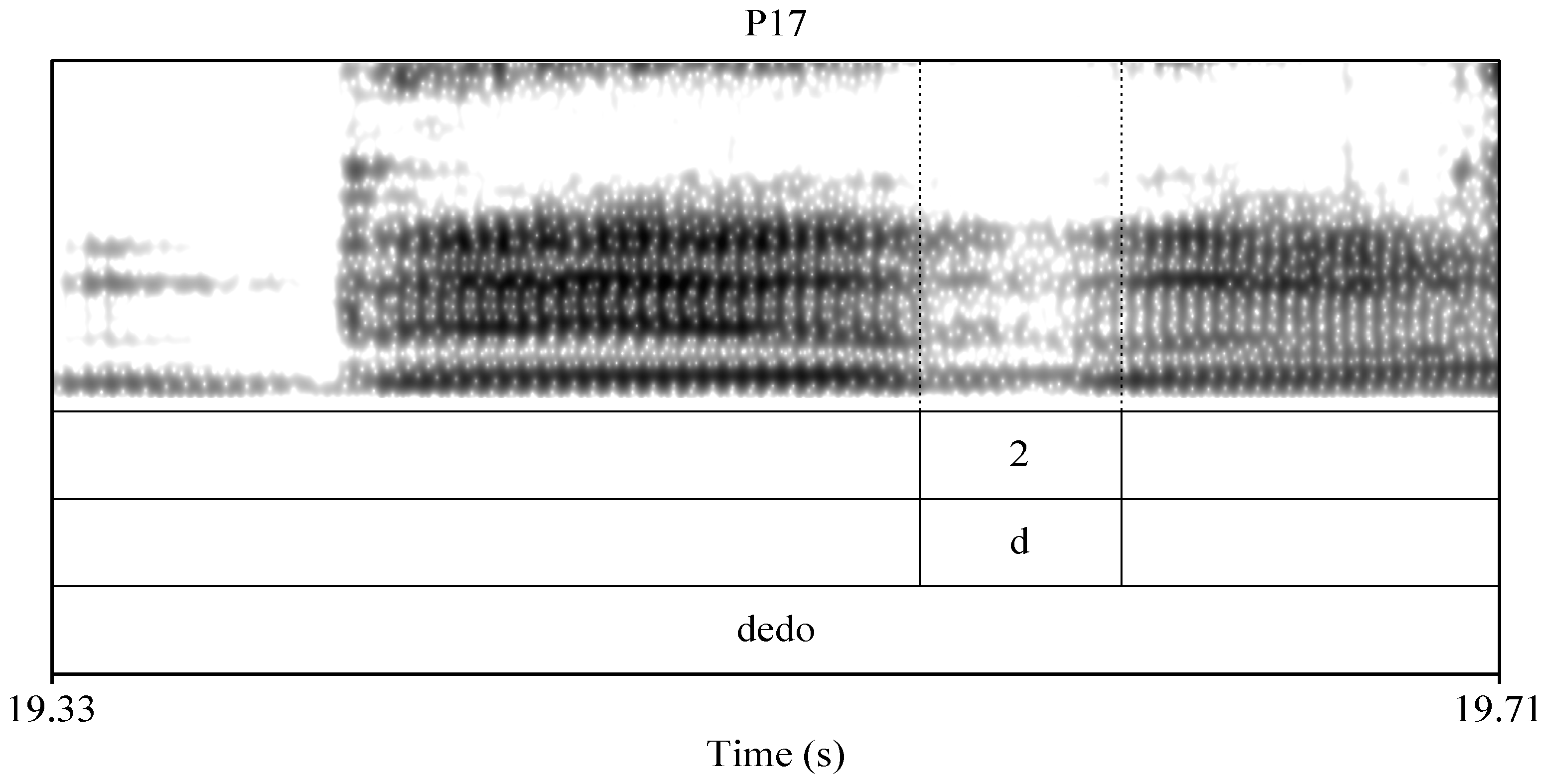
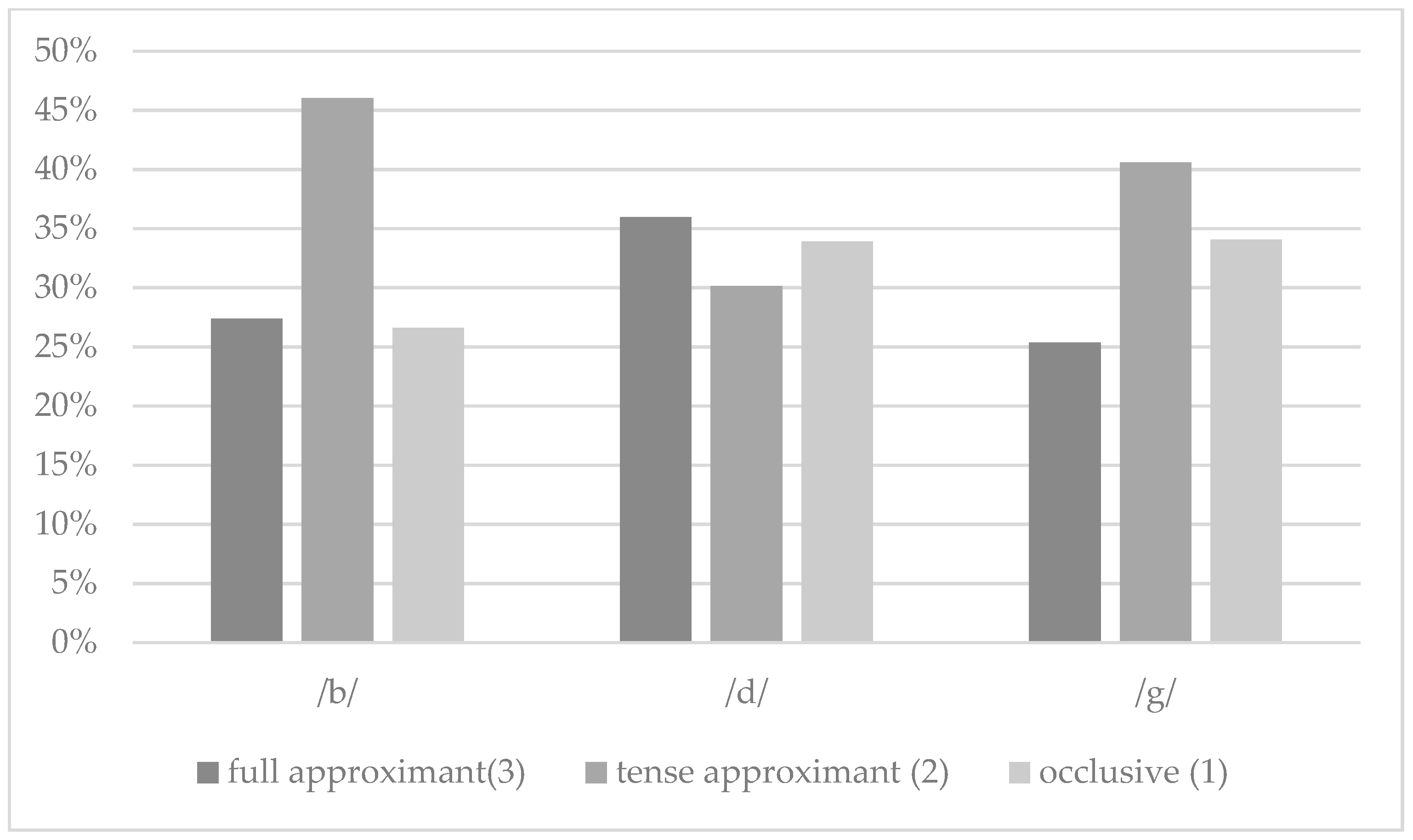
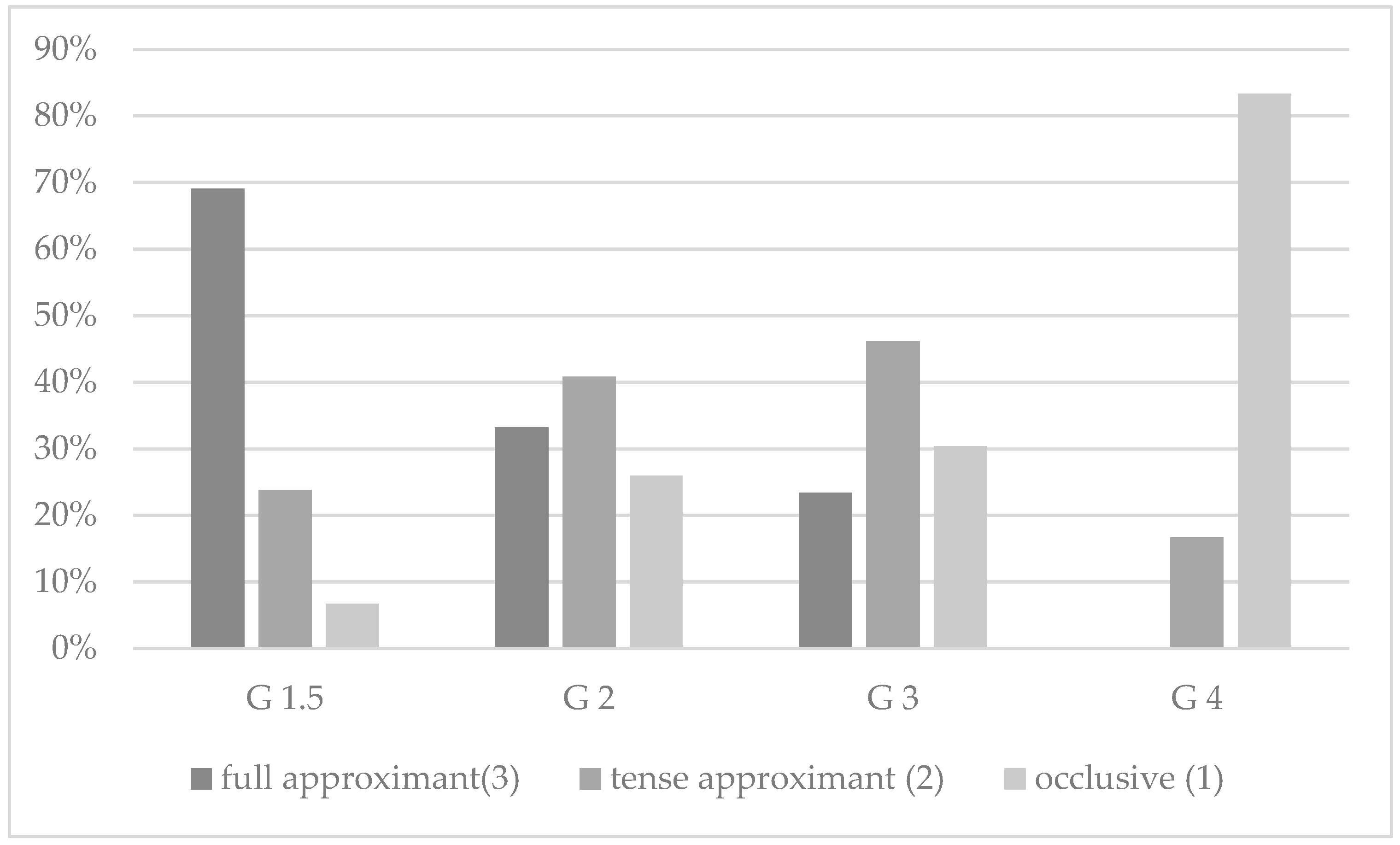
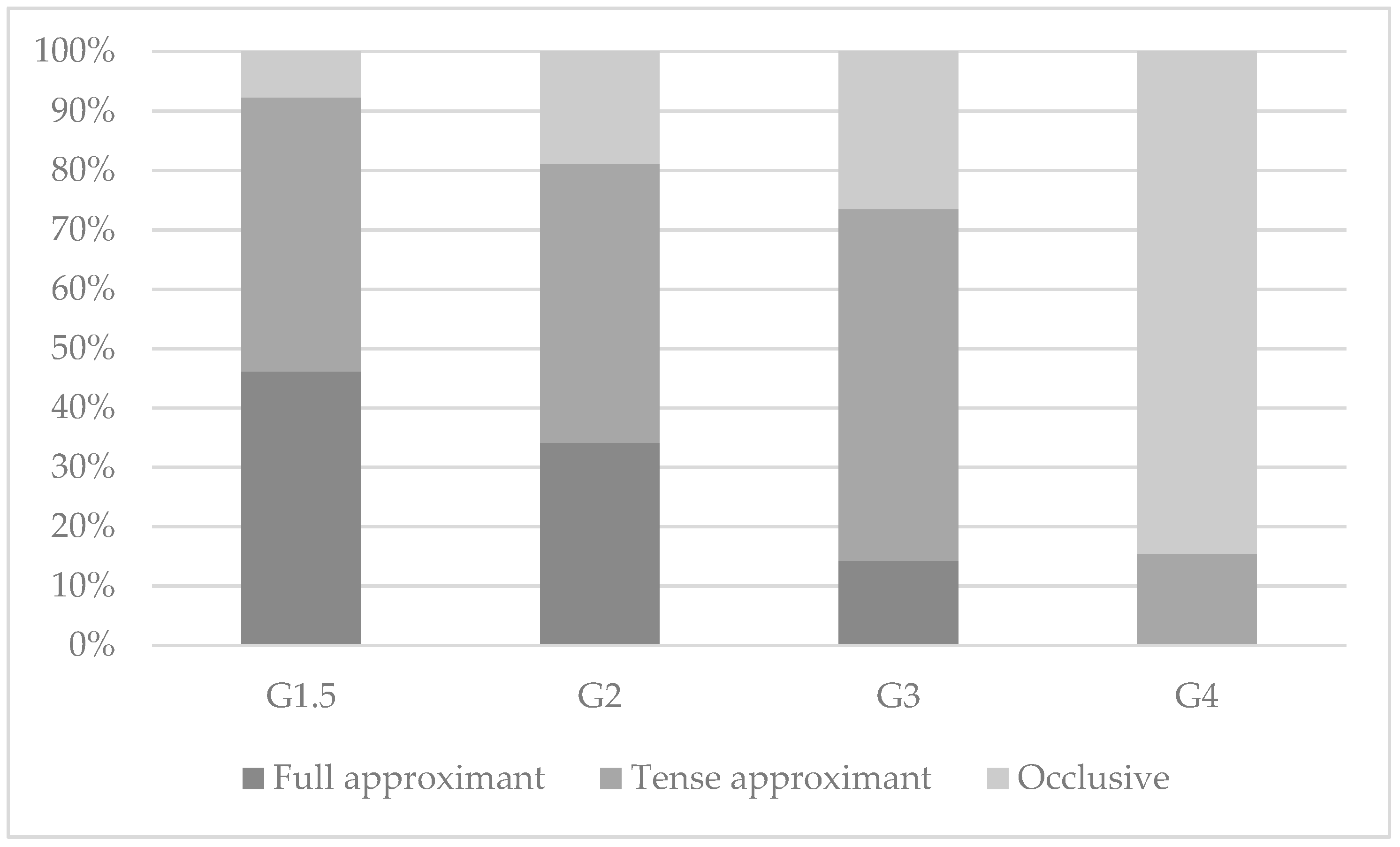

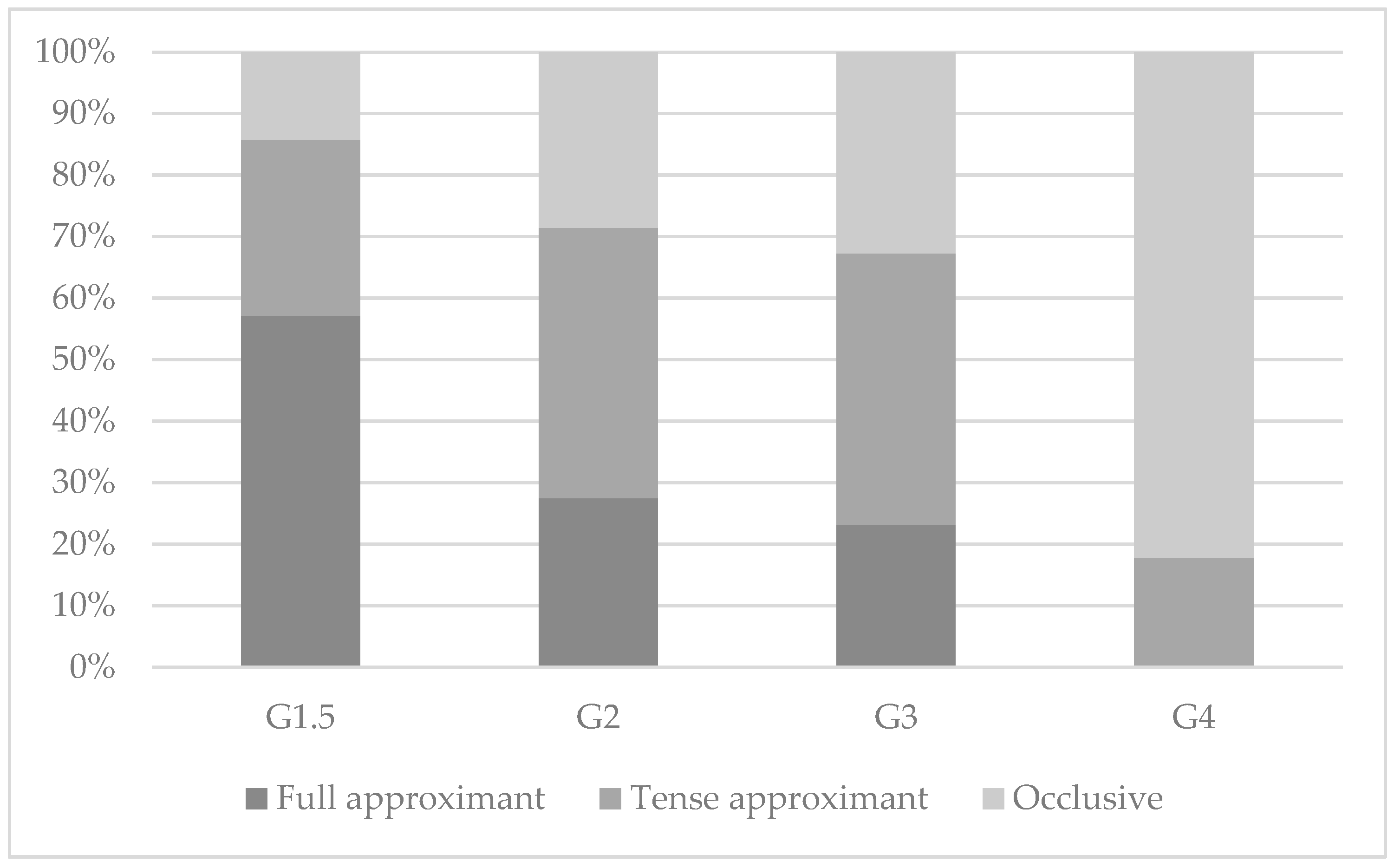
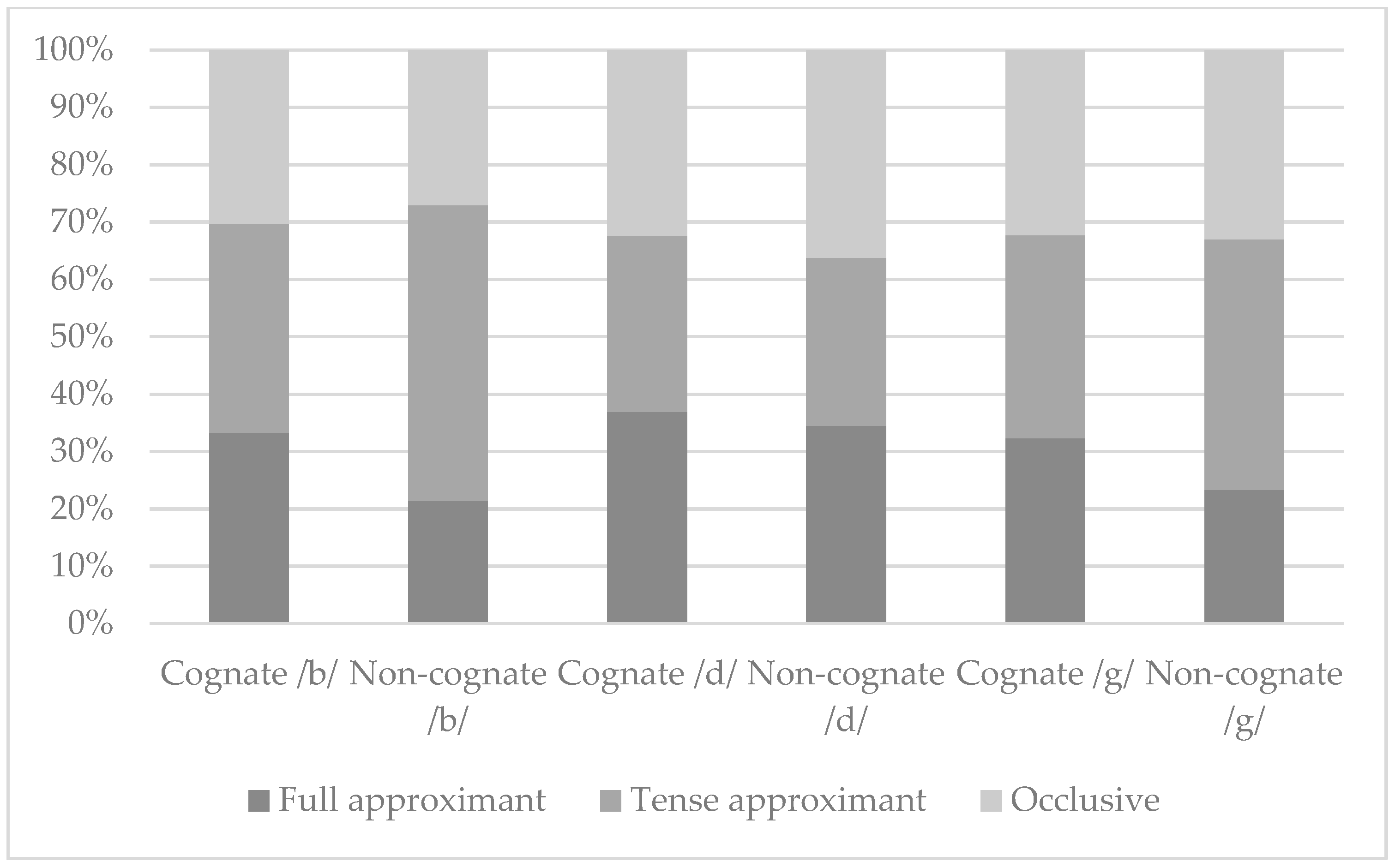
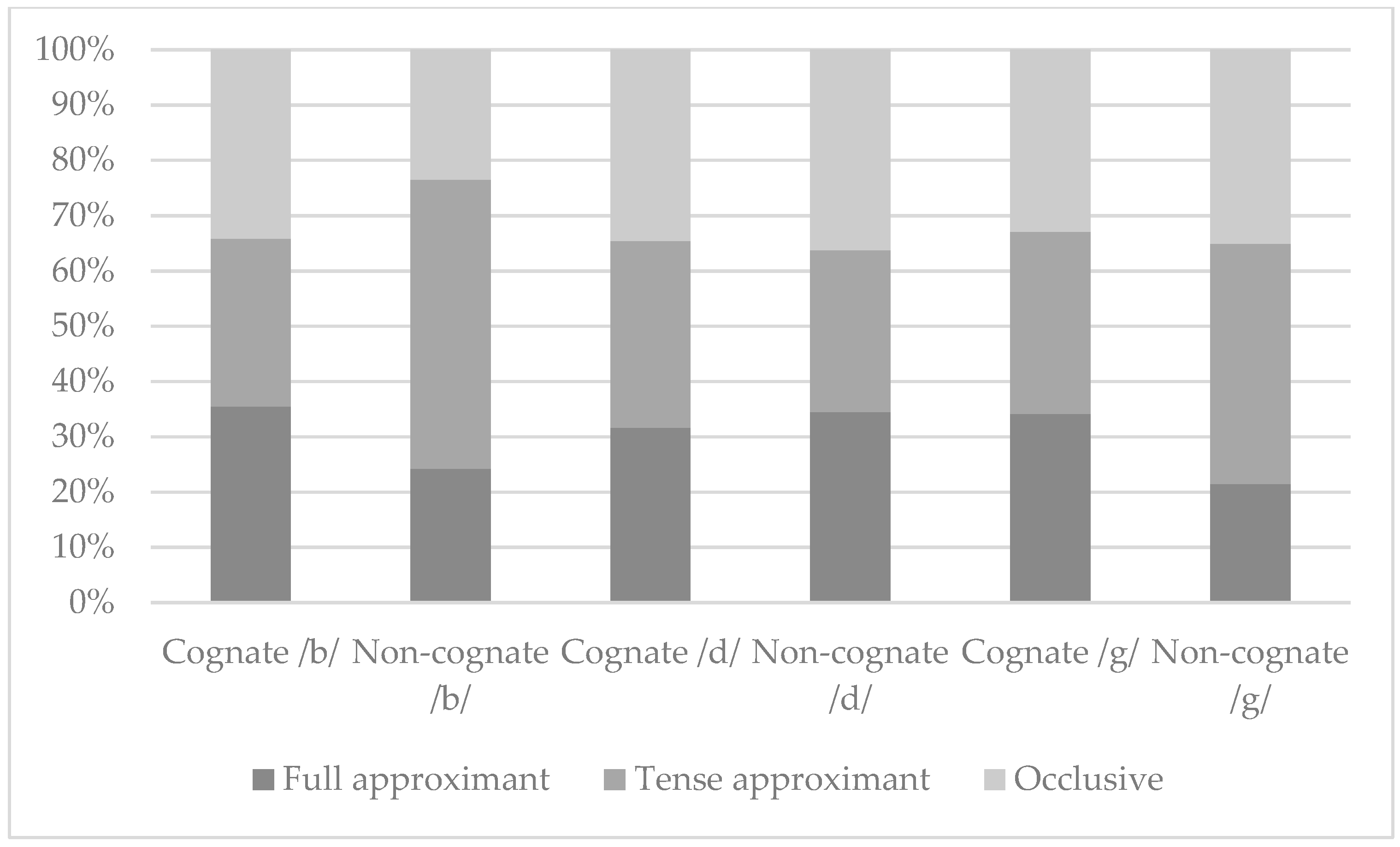
| n /b/ | % b | n /d/ | % d | n /g/ | % g | |
|---|---|---|---|---|---|---|
| Total | 252 | 292 | 276 | |||
| Syllable Stress | ||||||
| Atonic syllable | 172 | 68.3 | 195 | 66.8 | 197 | 71.4 |
| Tonic syllable | 80 | 31.7 | 97 | 33.2 | 79 | 28.6 |
| Preceding vowel height | ||||||
| Prec-low vowel | 132 | 52.4 | 115 | 39.4 | 59 | 21.4 |
| Prec-mid vowel | 60 | 23.8 | 77 | 26.4 | 158 | 57.2 |
| Prec-high vowel | 80 | 23.8 | 100 | 34.2 | 59 | 21.4 |
| Following vowel height | ||||||
| Foll-low vowel | 132 | 52.4 | 78 | 26.7 | 138 | 50.0 |
| Foll-mid vowel | 60 | 23.8 | 155 | 53.1 | 79 | 28.6 |
| Foll-high vowel | 60 | 23.8 | 59 | 20.2 | 59 | 21.4 |
| Cognate Status | ||||||
| Cognate | 99 | 39.3 | 176 | 60.3 | 99 | 35.9 |
| Non-cogate | 153 | 60.7 | 116 | 39.7 | 177 | 64.1 |
| Segment | Age | AoAS | Contact Hours | Generation | Phonetic Context | Cognate Status |
|---|---|---|---|---|---|---|
| /b/ | √ | √ | ||||
| /d/ | √ | √ | ||||
| /g/ | √ | √ |
Publisher’s Note: MDPI stays neutral with regard to jurisdictional claims in published maps and institutional affiliations. |
© 2021 by the authors. Licensee MDPI, Basel, Switzerland. This article is an open access article distributed under the terms and conditions of the Creative Commons Attribution (CC BY) license (https://creativecommons.org/licenses/by/4.0/).
Share and Cite
Blair, K.; Lease, S. An Examination of Social, Phonetic, and Lexical Variables on the Lenition of Intervocalic Voiced Stops by Spanish Heritage Speakers. Languages 2021, 6, 108. https://doi.org/10.3390/languages6020108
Blair K, Lease S. An Examination of Social, Phonetic, and Lexical Variables on the Lenition of Intervocalic Voiced Stops by Spanish Heritage Speakers. Languages. 2021; 6(2):108. https://doi.org/10.3390/languages6020108
Chicago/Turabian StyleBlair, Kaylyn, and Sarah Lease. 2021. "An Examination of Social, Phonetic, and Lexical Variables on the Lenition of Intervocalic Voiced Stops by Spanish Heritage Speakers" Languages 6, no. 2: 108. https://doi.org/10.3390/languages6020108
APA StyleBlair, K., & Lease, S. (2021). An Examination of Social, Phonetic, and Lexical Variables on the Lenition of Intervocalic Voiced Stops by Spanish Heritage Speakers. Languages, 6(2), 108. https://doi.org/10.3390/languages6020108





